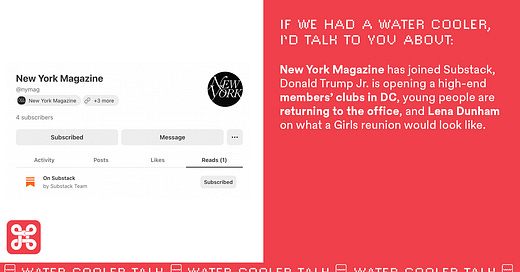Email jobs.
New York Magazine joins Substack, a Trump-founded DC members' club, and spumoni.
Good morning everyone. Happy to be back in your inboxes after throwing the most fun party of my life so far (my wedding), and mostly logging off for a week. I’m glad you all enjoyed the guest writers I brought in to keep the lights on while I was away. I promise that there will be more unexpected surprises to keep you on your toes this year!
I’m going to London next week for work, and I’m planning a Feed Me reader meetup one of the nights. I’m still trying to nail down what the plan is, so if you know of a bar or mansion or members’ club or something that would want to get in on this plan… email me. I’ll make sure to publish details in the letter ahead of time.
In today’s letter: New York Magazine told me about why they’re joining Substack, a six-figure job for a “smart, nerdy, and kind” writer, a new status symbol involving a pen and paper, a Trump-founded members’ club in DC that’s $500k/year, the dessert of the season, and Lena Dunham on what a Girls reunion would look like.
Yesterday, I asked my paid readers how they’d define a fake email job. I’d seen the term trickling back up on my various feeds over the past few weeks, and I correctly guessed it would be a term that people had definition for. Some readers even debated the existence of this title (which according to Know Your Meme, became legit in 2020).
This morning, I’m thinking about real email jobs. And how some of the realest, highest-paying, and most coveted jobs in media right now involve a heavy emphasis on emails.
Fewer people are reading homepages. Fewer people are typing in URLs.
Nobody really reads print magazines. What they do read is newsletters.
And newsletters depend on the most necessary and resilient piece of the internet: the inbox.
Many jobs are email jobs. One-to-one email jobs that are quite real by the standards of the modern economy, and not “fake email jobs.”
In fact, emails are uniquely important to media jobs, both for communication (one-to-one emails) and for distribution (one-to-many emails). Email is the highest-intent surface in media. If someone signs up for your list—without gimmicks—it’s your best shot at a real conversion: a subscription, a ticket sale, a purchase, or simply sustained attention, the rarest commodity of all.
Many good media jobs are “email jobs,” and newsletter jobs increasingly. The inbox is the new homepage, the inbox is the best distribution channel, the inbox is where so many of us spend a big portion of our screentime.
That’s why some of the most successful newsletters frame themselves as “industry publications” or “research products” even if they are, in reality, more like an inbox snack or distraction than true work.
These points also brought up a question in my head about the job market, and where young people should be positioning themselves. Would you rather be a social media manager, or a newsletter editor? Would your answer to that question have been different a year ago? If every organization goes from wanting your eyeballs on social and video to wanting to be the must-consumed notification in your inbox, that’s a very different game with different winners and audience experiences.
The Atlantic is looking for a driven, omnivorous (oh my!), and ideas-obsessed writer for their flagship newsletter, The Daily. The job description says that The Atlantic is building a team to not only assemble this letter, but also conduct interviews for the letter. One of the requirements is a deep interest in the competitive field of newsletters.
Similarly, The Wall Street Journal is hiring a writer for their biggest newsletter, The 10-Point. The role will work closely with the paper’s Editor in Chief, Emma Tucker. I don’t think that proximity to power would’ve been so explicitly outlined in a newsletter job description two years ago.





